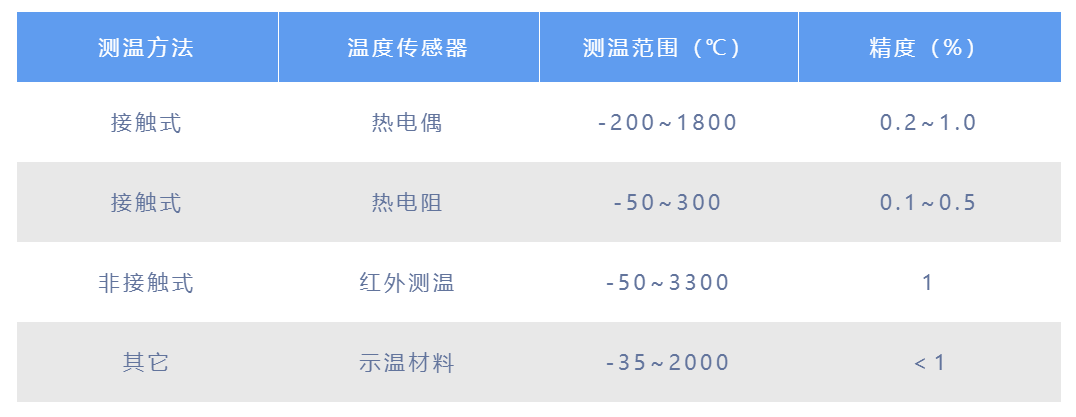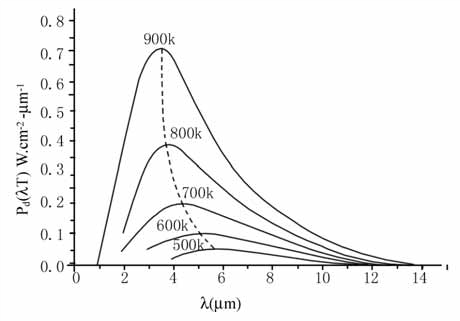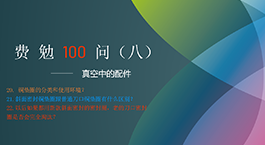 Your current location: Home > Technical Support > Popular Science Column > Fermion's 100 Q...
Your current location: Home > Technical Support > Popular Science Column > Fermion's 100 Q... 19. How does an infrared thermometer work? What does object distance ratio mean? Will the temperature measured by infrared thermometer be different for different materials at the same temperature?
When the temperature of an object in nature is higher than absolute zero, it continuously radiates electromagnetic waves to the surroundings due to the existence of internal thermal motion, including infrared rays with a wavelength of 0.75 ~ 100μm. Infrared thermometers are made based on this principle and have many advantages, such as easy use, fast response speed, high sensitivity, wide temperature measurement range, and the ability to achieve online non-contact continuous measurement.
Comparison of commonly used temperature measurement methods

Blackbody radiation
A black body is an idealized radiator that absorbs radiation energy of all wavelengths, has no energy reflection or transmission, and has a surface emissivity of 1. Other materials with a reflection coefficient less than 1 are called gray bodies. There is no real black body in nature, but in order to understand and obtain the law of infrared radiation distribution, a suitable model must be selected in theoretical research. Planck's black body radiation law, that is, the black body spectral radiance expressed in wavelength, is the starting point of all infrared radiation theories, as shown in the figure below.

As the temperature rises, the radiation energy of the object becomes stronger. This is the starting point of infrared radiation theory and the design basis of single-band infrared thermometer.
As the temperature rises, the radiation peak moves toward the short-wave direction (to the left) and satisfies Wien's displacement theorem T *λm = 2897.8 μm*K. The wavelength λm at the peak is inversely proportional to the absolute temperature Τ. The dotted line is the peak line at λm. This formula tells us why high-temperature thermometers mostly work at short waves and low-temperature thermometers mostly work at long waves. The rate of change of radiation energy with temperature is greater at shortwave than at longwave, that is, the thermometer working at shortwave has a high signal-to-noise ratio (high sensitivity) and strong anti-interference ability. The thermometer should try to work at the peak wavelength, especially in the case of low temperature and small targets. This is particularly important.
The infrared thermometer adopts a point-by-point analysis method, that is, the thermal radiation of a local area of the object is focused on a single detector, and the radiation power is converted into temperature through the known emissivity of the object. Due to the different objects to be detected, measurement ranges and usage occasions, the appearance design and internal structure of infrared thermometers are not exactly the same, but the basic structure is generally similar, mainly including optical system, photoelectric detector, signal amplifier and signal processing, display output and other parts.
arial, " microsoft="" font-size:="" text-wrap:="" background-color:=""/>Test error
Since infrared temperature measurement is non-contact, there will be various errors. There are many factors that affect the errors. In addition to the factors of the instrument itself, the main ones are:
● Emissivity
Emissivity is a physical quantity that measures the radiation capacity of an object relative to a black body. In addition to being related to the material shape, surface roughness, and concavity of the object, it is also related to the direction of the test. If the object has a smooth surface, its directionality is more sensitive. The emissivity of different substances is different, and the amount of radiation energy received by the infrared thermometer from the object is proportional to its emissivity.
When the emissivity of an object is higher, the reflectivity is smaller, and the background and reflection areThe smaller the impact, the higher the accuracy of the test; conversely, the higher the background temperature or the higher the reflectivity, the greater the impact on the test. In addition, the emissivity is also related to the test direction. The larger the test angle, the greater the test error. The test angle is best within 30° and generally should not be greater than 45°. If you have to test at a greater than 45°, you can appropriately lower the emissivity for correction.
●距离系数
距离系数(K=S:D)是测温仪到目标的距离S 与测温目标直径D The ratio of K to IR temperature has a great influence on the accuracy of infrared temperature measurement. The larger the K value, the higher the resolution. Therefore, if the thermometer must be installed far away from the target due to environmental conditions, and a small target needs to be measured, a thermometer with high optical resolution should be selected to reduce the measurement error. In actual use, many people ignore the optical resolution of the thermometer. Regardless of the size of the target point diameter D, turn on the laser beam and aim it at the measurement target for testing. In fact, they ignored the S:D value requirement of the thermometer, so the measured temperature will have a certain error.
●Target size
The object being measured and the field of view of the thermometer determine the measurement accuracy of the instrument. When using an infrared thermometer to measure temperature, generally only the average value of a certain area on the surface of the measured target can be measured. Generally, there are three situations in the test:
1> When the measured target is larger than the test field of view, the thermometer will not be affected by the background outside the measurement area, and can display the true temperature of the measured object in a certain area within the optical target. At this time, the test effect is best.
2> When the measured target is equal to the test field of view, the background temperature has been affected, but it is still relatively small, and the test effect is general.
3> When the target is smaller than the test field of view, the background radiation energy will enter the field of view of the thermometer and interfere with the temperature reading, causing errors. The instrument only displays the weighted average temperature of the object and the background. Therefore, it is recommended that the target size should exceed 50% of the field of view size during actual temperature measurement.

●Environmental factors
The environmental conditions of the measured object have a great influence on the measurement results. As the ambient temperature increases, the additional radiation effect will increase, and the temperature measurement error will also increase.
During the transmission of infrared radiation, the energy will always be attenuated due to the absorption of the atmosphere. Atmospheric absorption refers to the process of converting part of the infrared radiation energy into other forms of energy or distributing it in another spectrum during the transmission process. The degree of atmospheric absorption changes with the air temperature. The farther the object is, the greater the impact of atmospheric transmission on temperature measurement. Therefore, when performing infrared temperature measurement outdoors, it should be done in an environment without rain, fog, and clear air. When performing infrared temperature measurement indoors, it should be done in an environment without water vapor, so that more accurate values can be measured with minimal error.
How to Correctly Choose an Infrared Thermometer
There are three aspects to consider when choosing an infrared thermometer:
●Performance indicators, such as temperature range, spot size, operating wavelength, measurement accuracy, response time, etc.
●Environment and working conditions, such as ambient temperature, window, display and output, protective accessories, etc.
● Other options, such as ease of use, maintenance and calibration performance, and price.
Infrared thermometers include three series: portable, online and scanning, and are equipped with various options and computer software. Each series has various models and specifications. To select an infrared thermometer from various models of thermometers with different specifications, you should pay attention to the following aspects:
1> First, clarify the measurement requirements and the problems to be solved, such as the temperature of the target to be measured, the size of the target to be measured, the measurement distance, the material of the target to be measured, the environment in which the target is located, the response speed requirements, the measurement accuracy requirements, and whether to use a portable or online type;
2> Compare the measurement requirements and the problems to be solved with the various models of existing thermometers, and select the instrument model that can meet the above requirements;
3> Choose the best combination of performance, features and price from a wide range of models that meet your requirements.


